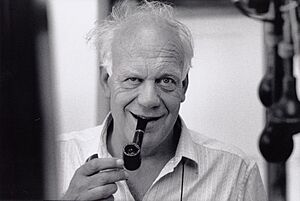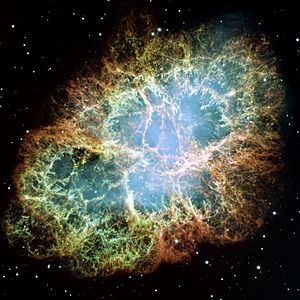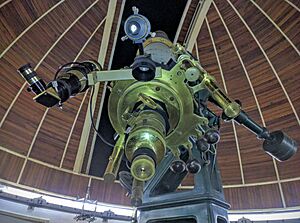Franco Pacini facts for kids
Quick facts for kids
Franco Pacini
|
|
|---|---|
 |
|
| Born | 10 May 1939 |
| Died | 25 January 2012 (aged 72) |
| Citizenship | Italian |
| Known for | pulsar, neutron stars |
| Awards | Prize of the Italian Government for Science (1997) |
| Scientific career | |
| Fields | Astrophysics |
| Institutions | University of Florence Arcetri Observatory |
Franco Pacini (born May 10, 1939 – died January 25, 2012) was an Italian scientist who studied space, called an astrophysicist. He was a professor at the University of Florence. He spent his career researching very energetic objects in space, a field known as High Energy Astrophysics. He worked in Italy, France, and the United States. He also worked with the European Southern Observatory.
Contents
Franco Pacini's Life Story
Franco Pacini was born in Florence, Italy, on May 10, 1939. He later moved to a town called Urbino. His father, Gualtiero Pacini, was a teacher. His mother, Elsa Roesch, was from Switzerland. In 1966, Franco married Rosemary Winterer, who was also a teacher. They had three children: Giulia, Tommaso, and Giorgio.
Pacini finished high school in Urbino. He then studied physics at important universities in Italy, first in Pisa and then in Rome. He graduated in 1964. For his final project, he wrote about neutron stars. At that time, neutron stars were just ideas, not yet proven to exist.
Discovering Pulsars and Neutron Stars
After university, Pacini continued his research on neutron stars in Paris, France. From 1967 to 1973, he worked at Cornell University in the United States. In 1967, he published an important idea in the science magazine Nature. He suggested that strongly magnetic neutron stars could spin very fast. This spinning could release huge amounts of energy and create fast-moving particles.
Just a few months later, scientists Jocelyn Bell Burnell and Antony Hewish discovered pulsars in Cambridge, UK. Pulsars are like cosmic lighthouses that send out beams of radiation as they spin. This discovery proved that Pacini's idea was correct!
In 1968, Pacini wrote another article in Nature. He predicted that a pulsar would be found at the center of the Crab Nebula. This pulsar would explain why the nebula gives off so much light and other radiation. Scientists later found that he was right.
Pacini also worked with another scientist, Martin Harwit. They suggested that bright infrared light from some starburst galaxies happens when many massive stars are forming. This idea is now widely accepted by scientists.
Working with the European Southern Observatory
In 1975, Pacini joined a new science group at the European Southern Observatory (ESO) in Geneva, Switzerland. He was the President of this group from 1975 to 1978. He also played a big part in helping Italy join ESO, which is a group that builds and operates powerful telescopes.
When he returned to Italy in 1978, he became the Director of the Arcetri Astrophysical Observatory in Florence. He also became a professor at the University of Florence. He led the Arcetri Observatory until 2001. During his time there, the observatory grew a lot. It started many new science projects and worked with other countries. For example, the Arcetri Observatory helped build the Large Binocular Telescope (LBT). This is one of the world's largest telescopes.
Sharing Science with Everyone
Franco Pacini was known for his ability to explain science in a fun way. He even used funny images to describe complex ideas. He was a member of many international science groups. He was the President of the International Astronomical Union (IAU) from 2001 to 2003. The IAU is a group that brings together astronomers from all over the world.
At an IAU meeting in 2003, Pacini suggested that 2009 should be called the International Year of Astronomy. This was to celebrate 400 years since Galileo first used a telescope to look at the sky. This idea was approved, and it helped many people learn about astronomy.
Pacini also loved to share science with the public, including children. He gave many public talks and wrote popular articles for newspapers. He also wrote books and appeared on television. He helped start "Children's Day" at the Arcetri Observatory.
Awards and Recognition
Franco Pacini received many awards for his work. In 1997, he received the Prize of the Italian Government for Science. An asteroid (a small rocky object in space) was even named after him: Asteroid 25601 Francopacini. He was also made an Honorary Citizen of Urbino in 2002.
Books for Kids
Franco Pacini wrote five children's books with Lara Albanese. These books help young readers learn about space:
- Verso le galassie lontane (Towards Distant Galaxies)
- Il nostro amico E.T. (Our Friend E.T.)
- In giro fra le stelle (Around the Stars)
- Visitiamo i pianeti (Let's Visit the Planets)
- Viaggio nell'universo: Verso le lontane galassie-In giro fra le stelle-Visitiamo i pianeti-Il nostro amico E.T. (Journey in the Universe: Towards Distant Galaxies-Around the Stars-Let's Visit the Planets-Our Friend E.T.)
Images for kids




